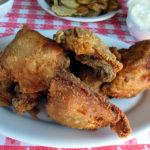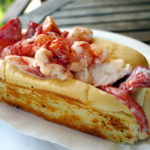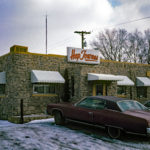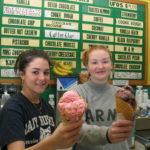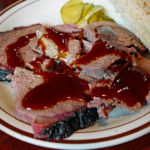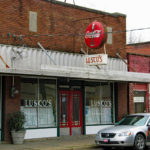Heartland Soda Fountain
If Dr. Seuss had been a restaurant reviewer, he would have liked soda fountains best, for they are where Pink Elephant punch and rootbeer Black Cows line up alongside marshmallow Rocky Roads; where emerald-bright Green Rivers flow and Banana Boats are launched. Though customarily located in a mundane pharmacy or dime store, the soda fountain is a realm of effervescent alchemy.
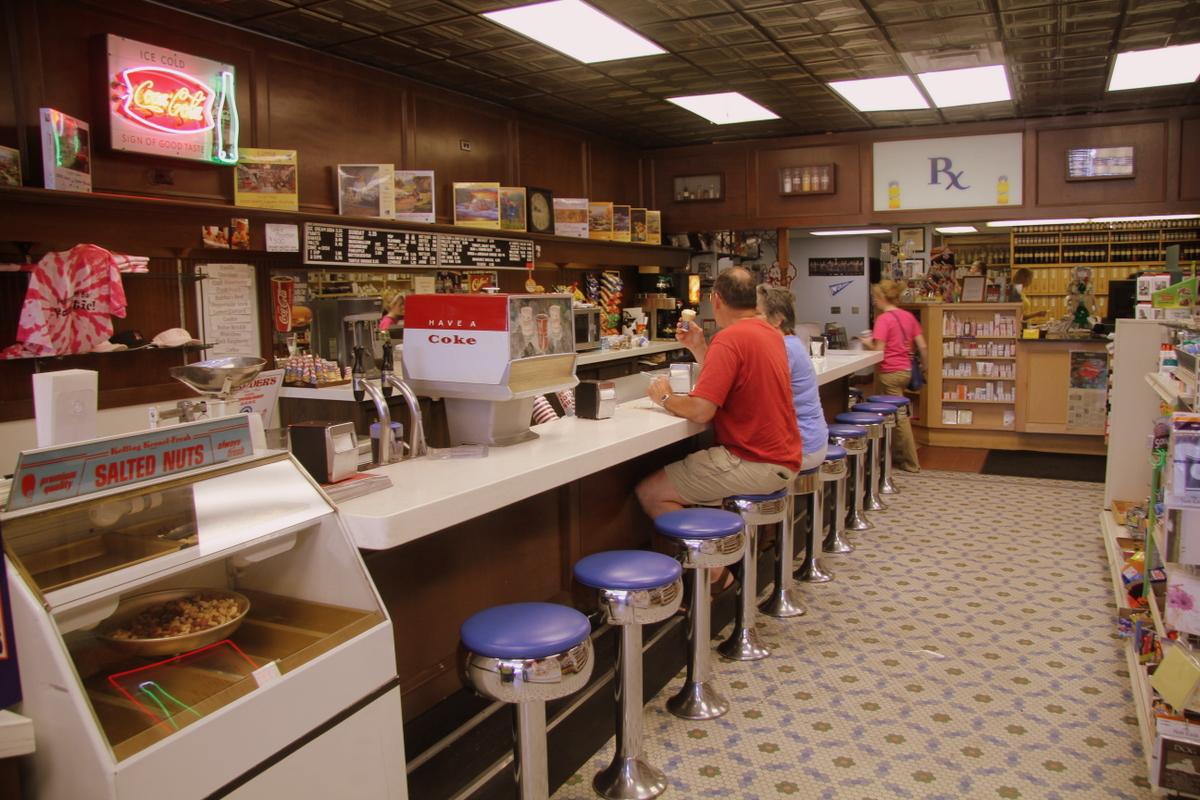
By Jane and Michael Stern
Originally Published 1998 Gourmet Magazine
If Dr. Seuss had been a restaurant reviewer, he would have liked soda fountains best, for they are where Pink Elephant punch and rootbeer Black Cows line up alongside marshmallow Rocky Roads; where emerald-bright Green Rivers flow and Banana Boats are launched. Though customarily located in a mundane pharmacy or dime store, the soda fountain is a realm of effervescent alchemy.
The master of the fountain is the soda jerk, a job description that refers to the ability to stylishly jerk the handle of a seltzer dispenser and thereby give inert ingredients carbonated life. The art of the soda jerk, like the lingo, has all but vanished from popular culture. Few—if any—modern mixologists know the difference between a Chicago and a Hoboken. (The former is a pineapple ice-cream soda; the latter, a pineapple soda made with chocolate ice cream.) And rare is the connoisseur who can stride up to a marble counter and call out, “Shoot one long, to the left!” when he wants a shot of lemon syrup in a large Coke. (The lemon pump was traditionally located to the left of the Coke syrup pump; a long drink is a large one.)
Deluxe in its confectionery folderol yet democratic in its attitude, enjoyed by sybarites of all ages and means, the traditional soda fountain was once as basic a part of America’s communities as the barber shop. What is most curious about its nostalgic aura is the way it blends innocence and sophistication. This bygone charisma was enticingly captured in an 1892 Pharmaceutical Era journal description of the counter at Huyler’s in New York City:
The fountain at Huyler’s is the shrine before which the Vassar girl bows down in worship. The gently sparkling liquid, with its soft lumps of frozen delight, has a peculiarly soothing effect upon the membrane of the Vassar girl’s graceful throat, and there is no more inspiring sight these days than is afforded by a group of these fair creatures seated before a fountain, gracefully delving with the long, slender spoon and giving little gurgles of delight on successfully fishing from the foamy depths frozen particles of delicious chocolate or fruity strawberry.
Every adult American who grew up in this century has a good idea what a soda fountain is—a counter with stools, behind which are dispensers with nozzles to squirt out soda, push-pumps to draw from vats of flavored syrup, and silver refrigerated cases holding ice cream. For the record, “soda fountain” has a different connotation than “ice-cream parlor,” though the two share many charms. In an ice-cream parlor (which may or may not have soda dispensers), the quality and flavor of the ice cream is of paramount concern. At a soda fountain, on the other hand, ice cream is rarely something superduper; it may be of high quality, but it is just one constituent among many. The real appeal of a good soda fountain lies in the dexterity of the soda jerk, who combines ice creams, syrups, seltzer, nuts, et al with the vision of a master builder and the sleight-of-hand sorcery of a prestidigitator.
Early soda fountains offered no ice cream at all. In the years after the Civil War, when refrigeration was a luxury and air conditioning did not exist, they were oases of cool, carbonated water in department stores, pharmacies, confectioneries, and dairy restaurants. A bubbly libation was still something of a marvel, and soda-water dispensers reinforced the image of whimsical gratification. Ice-cream historian Anne Cooper Funderburg writes that late-nineteenth-century fountain designers borrowed elements from “Gothic, Roman, Byzantine, Egyptian, and Oriental architecture to create fancy fountains with imaginative names: the Transcendent, the Nonpareil, the Titania, the Spectre, the Meteor, the Frost King, the Ice Floe, the Avalanche, and the Cathedral.” Nor was there anything ordinary about the astonishing repertoire of flavorings, which Ms. Funderburg reports included “almond, anise, apple, apricot, banana, birch beer, blackberry, blood orange, calissaya, champagne cider, cherry, chocolate, cinnamon, Java and mocha coffee, cognac, coriander, cream soda, currant, excelsior bouquet, ginger, gin-ger ale, gooseberry, grape, greengage, grenadine, hoarhound, julep, lemon, Persian and Bavarian mead, mint julep, mulberry, nectar, nutmeg, orange, orange sherbet, orris root, peach, peach cider, pear, pear cider, peppermint, phosphate, pineapple, plum, quince, raspberry, raspberry cider, root beer, rose, sarsaparilla, sherbet, strawberry, tonic beer, vanilla, wild cherry, and wintergreen.”
At a nickel a glass, soda water was cheap, wholesome refreshment. From the Victorian era through Prohibition (when seltzer was promoted as “temperance champagne”) and into pop culture’s pre-Beatles salad days, the soda fountain grew to be America’s salubrious alternative first to the saloon and then to the open-all-night diner. While many soda fountains have vanished in other parts of the country, the Midwest still has a handful of enduring classics.
For as long as anyone can remember, nothing has changed at the PENN DRUG soda-fountain counter in Sidney, Iowa, where tradition decrees that if you visit on your birthday, you get the ice-cream soda of your choice for free. There is nothing self-consciously antique about this store, which opened in 1863 and continues to stock all the knickknacks, liniments, and sundries that made pharmacies such convenient neighborhood emporia in the decades before malls and superstores. Every day at dinner (that’s the midday meal) citizens of southwestern Iowa’s farmland take places at the twelve counter stools and three tables, where they eat chicken or ham salad sandwiches and, if they’re feeling sporty, dip long-handled spoons into expertly made ice-cream sodas. Penn’s sodas are served in tall, fluted glasses with billows of whipped cream piled high above their rims. Cherry, chocolate, and strawberry are the most popular kinds, but there are more festive varieties available here than there are colors in a good-sized pack of Crayolas.
On the other side of Iowa, in the tiny town of Wilton, the WILTON CANDY KITCHEN just may be the oldest soda fountain in the nation. Fizz-biz historians trace a fountain at this spot to the mid-1880s; today’s Candy Kitchen dates from 1910, when a young immigrant named Gus Nopoulos came to town and rented the place to make candy and sell soda and ice cream. Now run by Gus’s descendants, the Candy Kitchen is a trip back to a world of long-forgotten concoctions such as the Pink Lady (strawberry, cherry, and vanilla flavorings), the Oddball (strawberry and vanilla), and the Dipsy Doodle (six different flavors). You can also get a Hadacol (root beer and vanilla), the name of which George Nopoulos explains as: “They ‘hada call’ it something.” And when you order a Coke or a cherry Coke, the soda is not poured from a bottle or can, but mixed to order, using Coke syrup and water carbonated on the premises. Mr. Nopoulos told us that Coke syrup, once a fountain staple in every American town, is getting hard to find. “We’ve got to go all the way to Cedar Rapids for it now,” he lamented.
Iowa’s capital city, Des Moines, is home to yet another bubbly blast from the past: BAUDER’S PHARMACY, where proprietor Mark Graziano is master of his Coke machine. He pulls down its handle with the authority of a jet pilot kicking in the afterburner. A perfect mix of seltzer and Coke syrup bubbles into a shapely soda-fountain glass. “You can have a cherry Coke”—he squirts a shot of maraschino-red syrup in the Coke. “Or vanilla”—he draws another glass in an instant. “Or even chocolate. You can have a Green River, too. That’s seltzer and sweet lime syrup.” He offers us the fizzy green soda to taste, then snatches back the glass and asks, “Do you know what a phosphate is?” Before we can answer, he adds a tiny dash of citric acid, swirls the liquid with a spoon, and returns the phosphate for a taste, a drink deliciously piquant instead of purely sweet.
Mr. Graziano also makes a fine Turtle sundae (that’s with caramel, nuts, and hot fudge topping), along with shakes, malts, sodas, and floats of every stripe, all constructed from Bauder’s superb ice creams. Like the nostalgic reverberations of the Coke machine, those of this drugstore soda fountain hark back not to Victorian days, but to midcentury middle America. The business was founded in 1922 by Caroline Bauder, a pharmacist whose motto was “Cleanliness, Order, Service.” After World War II Mark Graziano’s father became a partner and started making ice cream in the front window. Today the fixtures are comfortably familiar but not prehistoric—a colorful octagon-tile floor; blue-upholstered stools and several booths back near the prescription counter; a small glass case of warm salted nuts; and a waist-high cooler with pints of delicious ice cream packed and ready to take home.
Iowa is particularly rich with soda fountains, but there are gems throughout the Midwest, wherever a taste for tutti-frutti endures. One of the most beautiful is ZAHARAKO’S, in Columbus, Indiana, featuring a mahogany back bar, twin onyx fountains, and an eye-and-ear-boggling, self-playing organ that blares out John Phillip Sousa marches. Now preparing to celebrate its centennial in the year 2000, Zaharako’s is the embodiment of anachronous mixology where you can get an excellent sarsaparilla, a Fireball, a cinnamon Coke, or fresh lemonade or orangeade. Lunch-counter epicures also know it for a unique sandwich listed on the menu as a “cheese-br-ger.” Like a cheeseburger, a cheese-br-ger is a beef-and-cheese combo—but in this case made with spicy beef chili and gilded with a slab of Velveeta. These ingredients are sandwiched between two slices of white bread that are then toasted on a grill. Suggested beverage: a sixteen-ounce chocolate soda served in a green-tinted, bell-shaped glass.
In Manitowoc, Wisconsin, BEERNTSEN’S is best known as a candy store where the ethereal spun-molasses “fairy food” chocolates are enough to coax angels out of heaven. Delicious as the candies and ice-cream sodas are in this lovely 1930s-vintage sweetshop, we are most smitten by the sundaes, made with Beernsten’s own ice cream and a choice of fudge, caramel, butterscotch, marshmallow, maple, strawberry, raspberry, cherry, or pineapple topping. How rapturous it is to occupy one of the finely carved black-walnut booths in the back and spoon into a Scotch Lassie (butterscotch and marshmallow on vanilla ice cream with pecans) or a Hog ‘n’ Dog (vanilla ice cream with chocolate syrup, chocolate sprinkles, a cherry, and a solid-chocolate pig and dog on top).
The CROWN CANDY KITCHEN of St. Louis is a grand tin-ceiling café that offers a deal to insatiable malt lovers—drink five in thirty minutes, and you get them free. Warning: These are super thick malts, served in high silver carafes that each hold nearly three tall glassfuls. All the usual flavors are available; the house special is fresh banana dusted with grated nutmeg. Sodas are superb—chocolate, vanilla, and crushed fruit—as are sundaes, banana splits, and extra-elegant “French” sundaes topped with crushed toasted cashews and chocolate sprinkles. A St. Louis institution since 1913, the Crown Candy Kitchen is packed with Victorian memorabilia, including a five cent scale that reads your horoscope, as well as the more modern amenity of a jukebox in every booth along the wall.
The beautiful marble-topped counter at EDGAR’S was first installed at Edgar Schmiedt’s Drugstore soda fountain, in Centerville, South Dakota, in 1906. It was retired in the 1960s but rediscovered about two decades later by Edgar’s granddaughter Barb Wurtz and her husband, Kevin, who restored it as the centerpiece of the fountain they opened adjacent to their pharmacy in Elk Point, South Dakota.
Passionate about making their fountain authentic, the Wurtzes put in a tin ceiling, a mirrored back bar, iron-rod tables, and wood booths, and they based their menu on sweetshop manuals from the turn of the century. Proverbial malts, shakes, and sundaes at Edgar’s are supplemented by such swoonful combos as a Black Diamond (chocolate ice cream slathered with hot fudge) and a Rocket (a vertical banana split). Phosphates and sodas are especially inventive here, ranging from doctored-up colas to the Idiot’s Delight—a little squirt of every kind of syrup in the house.
SAYWELL’S DRUGSTORE has been a main-street meeting spot in the small Ohio town of Hudson since 1909. Citizens still gather on red-upholstered stools at the black-marble counter early every morning to exchange news and opinions over cups of coffee. Later in the day, sweets rule. Veteran soda clerk Mary Ann Howe explained that chocolate sodas are especially popular because the chocolate syrup itself is so good—made on the premises, like all Saywell’s flavorings. Ms. Howe also explained that a phosphate hereabouts is simply soda water and the syrup flavor of choice. An egg cream in these parts is the same formula, plus a shot of cream. With expertise honed fine by experience, she demonstrated the exact technique of making an egg cream. First, flavoring and cream are swirled in the bottom of the glass. Then the glass is held under the fountain nozzle, the paddle of which is pushed back so a furious, pinpoint stream of seltzer squirts down and mixes the cream and flavoring in a fizzy burst. When the glass is half full, the paddle is pulled forward, allowing a leisurely flow of seltzer to fill it.
Started as a Moline, Illinois, candy store in 1908, LAGOMARCINO’S is still renowned for hand-dipped chocolates and for fancy fruit baskets. An aged wooden booth in this fine old establishment is also a nice place to have ham-on-rye for lunch. But the one thing you must try if you are a newcomer to Lagomarcino’s is the hot fudge topping. Made from a recipe acquired in 1918 from a traveling salesman for the princely sum of $25, this bittersweet, not-too-thick elixir is simply the best hot fudge in this solar system or any other.
When you order a sundae, the great, dark stuff is served in a manner befitting its distinction—in a small pitcher alongside the tulip glass filled to the brim with ice cream and soft billows of whipped cream, so you can pour or spoon the sauce to taste. This serving technique provides a fascinating demonstration of how one’s soda-fountain habits reflect one’s personality. Do you pour on all the hot fudge at one time, willy-nilly, risking that some will spill over the sides of the serving glass? Do you drizzle it on spoonful by meticulous spoonful, carefully ensuring that every bite will have just the proper balance of ice cream and fudge? Or do you eat all the ice cream first (with maybe just a dash of fudge), so you can then conclude your snack by downing all the hot topping that remains in one dizzy chocoholic binge?
Edgar’s (permanently closed)
107 East Main Street
Elk Point, South Dakota
Lagomarcino’s
Penn Drug
Saywell’s Drugstore (permanently closed)
160 North Main Street
Hudson, Ohio
Zaharako’s
Discuss
What do you think of Heartland Soda Fountain?
Related Articles
Stroud’s
By Jane and Michael Stern Originally Published 1995 Gourmet Magazine Chicken...
The Lobster Roll Honor Roll
Maine is the only state in America that features a picture of cooked food on its license...
Meat-And-Three
A few years back, country singer Ray Stevens invited a New York friend to join him at one of...
Top 12 favorite Ice Cream Scoops
WITH THE EXCEPTION of the hot dog bun, there has never been an edible invention as...
Top 5 BBQ Restaurants | Western Kentucky
Get yourself to Western Kentucky for great BBQ I see the food shows on TV where...
Best restaurants in Greenwood, MS | Hot Licks Delta Style
Ever since we first ate margarine-sauced pompano at Lusco’s, in Greenwood,...

